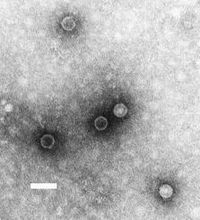
Photo from wikipedia
Objectives To examine the association between Helicobacter pylori seroprevalence and serum pepsinogens (PGs) as markers of gastric inflammation), with high neutralizing antibody titers to poliovirus type 1 and 3 vaccine… Click to show full abstract
Objectives To examine the association between Helicobacter pylori seroprevalence and serum pepsinogens (PGs) as markers of gastric inflammation), with high neutralizing antibody titers to poliovirus type 1 and 3 vaccine strains among children age 3–4 years, subsequent to sub-clinical infection acquired during a wild-type poliovirus type 1 outbreak in Israel. Methods A serosurvey was conducted among 336 children aged 5–17 years who were vaccinated with both inactivated polio vaccine and oral polio vaccines. H. pylori serum IgG antibodies and PG concentrations were measured using ELISA. Neutralizing antibodies to poliovirus vaccine strains were measured and children with a titer ≥1:8 were considered immune. High-level immunity was defined as having a serum NA titer >1:2048. Propensity score inverse weighting was used to account for confounders. Results Neutralizing antibodies titers ≥1:8 to poliovirus type 1 and 3 vaccine strains were found in 99.4 and 98.2% of the children, respectively. An inverse association was found between H. pylori seropositivity accompanied by PGI:PGII ratio ≤6.5 (marker of gastric inflammation) and high-level immunity to poliovirus type 1: OR 0.39 (95% CI 0.68–0.91), p = 0.027. The association between H. pylori seropositivity of CagA virulent phenotype and polio high immunity was not significant. The association between H. pylori seropositivity and high neutralizing antibodies to type 3 poliovirus was of low magnitude and not significant. Conclusions H. pylori seroprevalence accompanied by evidence of gastric inflammation was inversely correlated with high titers of neutralizing antibodies to poliovirus in children from a population with near universal polio immunity.
Journal Title: Frontiers in Medicine
Year Published: 2021
Link to full text (if available)
Share on Social Media: Sign Up to like & get
recommendations!